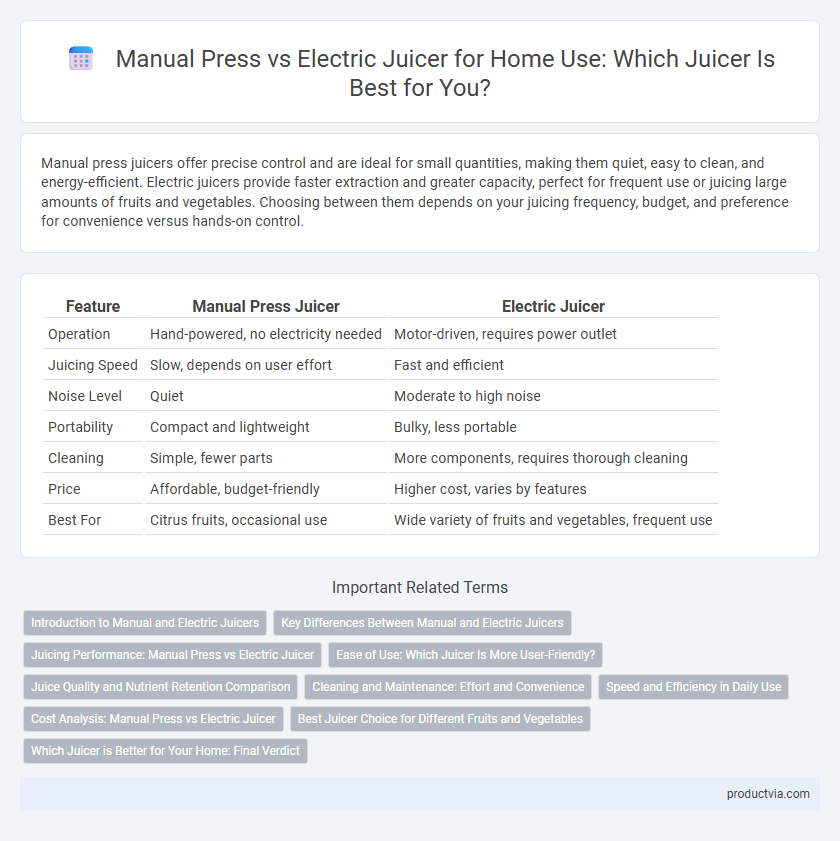Manual press juicers offer precise control and are ideal for small quantities, making them quiet, easy to clean, and energy-efficient. Electric juicers provide faster extraction and greater capacity, perfect for frequent use or juicing large amounts of fruits and vegetables. Choosing between them depends on your juicing frequency, budget, and preference for convenience versus hands-on control.
Table of Comparison
| Feature | Manual Press Juicer | Electric Juicer |
|---|---|---|
| Operation | Hand-powered, no electricity needed | Motor-driven, requires power outlet |
| Juicing Speed | Slow, depends on user effort | Fast and efficient |
| Noise Level | Quiet | Moderate to high noise |
| Portability | Compact and lightweight | Bulky, less portable |
| Cleaning | Simple, fewer parts | More components, requires thorough cleaning |
| Price | Affordable, budget-friendly | Higher cost, varies by features |
| Best For | Citrus fruits, occasional use | Wide variety of fruits and vegetables, frequent use |
Introduction to Manual and Electric Juicers
Manual juicers rely on hand power to extract juice, offering affordability and quiet operation, ideal for small quantities of citrus fruits. Electric juicers use motorized mechanisms to quickly process a variety of fruits and vegetables, providing convenience and higher juice yield for regular home use. Choosing between manual and electric juicers depends on frequency of use, desired efficiency, and budget considerations.
Key Differences Between Manual and Electric Juicers
Manual press juicers require physical effort to extract juice and typically offer greater control over pulp and texture, making them ideal for small batches and citrus fruits. Electric juicers provide faster, more efficient juice extraction with higher output suitable for a variety of fruits and vegetables, featuring multiple speed settings and automated pulp separation. Maintenance varies as manual juicers are easier to clean with fewer parts, while electric models often require more thorough cleaning and careful handling of electrical components.
Juicing Performance: Manual Press vs Electric Juicer
Manual press juicers excel in extracting juice from citrus fruits with minimal oxidation, preserving more nutrients and flavor, but require more physical effort and time. Electric juicers deliver faster juicing performance suitable for a variety of fruits and vegetables, including hard produce, providing higher juice yield through powerful motors and advanced extraction mechanisms. Choosing between a manual press and electric juicer depends on the desired balance between juice quality, ease of use, and speed for home juicing needs.
Ease of Use: Which Juicer Is More User-Friendly?
Manual press juicers require physical effort and more time to extract juice, making them less convenient for frequent use. Electric juicers offer one-touch operation and faster juicing, enhancing ease of use and efficiency in the kitchen. For home use, electric juicers are generally more user-friendly, especially when handling larger quantities or harder fruits and vegetables.
Juice Quality and Nutrient Retention Comparison
Manual press juicers typically preserve juice quality and nutrient retention better due to their slow, cold-press extraction process, which minimizes heat and oxidation. Electric juicers, especially centrifugal models, may generate heat and introduce more oxygen, potentially reducing vitamin C content and enzyme activity. For maximizing antioxidants and enzymes, cold-press manual juicers or slow masticating electric juicers are preferred over high-speed centrifugal alternatives.
Cleaning and Maintenance: Effort and Convenience
Manual press juicers require minimal parts and simple assembly, making cleaning quick and straightforward, with most components easily rinsed or scrubbed by hand. Electric juicers often have more intricate mechanisms, including multiple detachable parts and filters that may require thorough cleaning under running water or soaking to prevent pulp buildup. While manual presses excel in low maintenance and convenience, electric juicers demand more effort to maintain optimal performance and hygiene after each use.
Speed and Efficiency in Daily Use
Manual press juicers require more physical effort and time to extract juice, making them less efficient for daily use compared to electric juicers. Electric juicers offer faster juice extraction with higher yield due to powerful motors and advanced mechanisms. For users prioritizing speed and convenience, electric juicers are the optimal choice for efficient home juicing.
Cost Analysis: Manual Press vs Electric Juicer
Manual juicers typically cost between $20 and $50, making them a budget-friendly option with minimal maintenance expenses. Electric juicers range from $70 to over $300, reflecting various features, motor power, and build quality that influence price. Considering long-term use, manual presses incur lower energy costs, while electric models offer faster juice extraction but higher initial and energy expenses.
Best Juicer Choice for Different Fruits and Vegetables
Manual press juicers excel with citrus fruits like oranges and lemons, providing efficient juice extraction while preserving flavor and nutrients. Electric juicers handle a wider variety of fruits and vegetables, including harder produce such as carrots and beets, offering faster processing with higher yield. Choosing the best juicer depends on the target ingredients: manual presses suit soft, juicy fruits, while electric models are ideal for tougher, fibrous vegetables.
Which Juicer is Better for Your Home: Final Verdict
Manual press juicers offer precise control, quieter operation, and easier cleaning, making them ideal for small batches and citrus fruits. Electric juicers provide faster processing, higher juice yield, and versatility with various fruits and vegetables, supporting busy lifestyles and larger volumes. Choosing the best juicer depends on your specific needs for speed, noise level, ease of use, and the types of produce you frequently juice.
Manual press vs Electric juicer for home use Infographic

 productvia.com
productvia.com